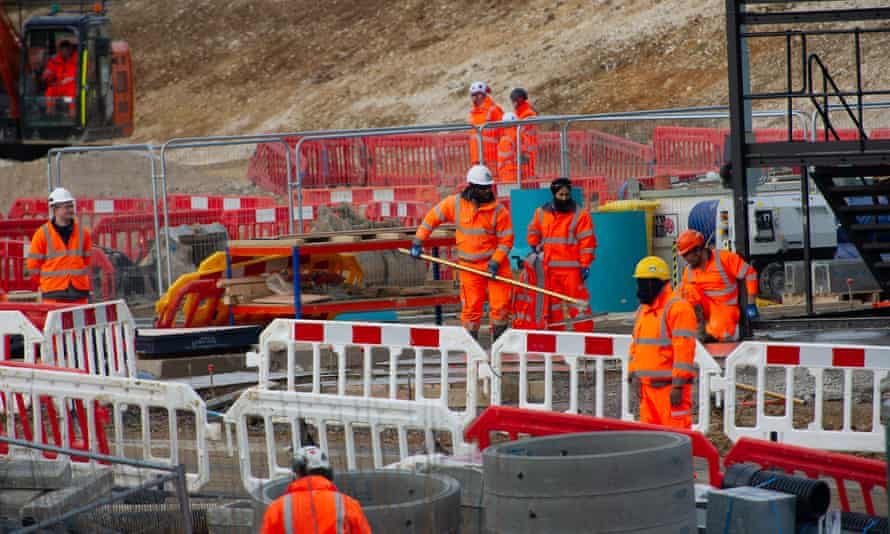We can’t build our way out of the environmental crisis

New infrastructure projects are all the rage, post-pandemic. But who benefits from a rising tide of concrete?

Dig for victory: this, repurposed from the second world war, could be the slogan of our times. All over the world, governments are using the pandemic and the environmental crisis to justify a new splurge of infrastructure spending. In the US, Joe Biden’s bipartisan infrastructure framework “will make our economy more sustainable, resilient, and just”. In the UK, Boris Johnson’s build back better programme will “unite and level up the country”, under the banner of “green growth”. China’s belt and road project will bring the world together in hyper-connected harmony and prosperity.
Sure, we need some new infrastructure. If people are to drive less, we need new public transport links and safe cycling routes. We need better water treatment plants and recycling centres, new wind and solar plants, and the power lines required to connect them to the grid. But we can no more build our way out of the environmental crisis than we can consume our way out of it. Why? Because new building is subject to the eight golden rules of infrastructure procurement.
Rule 1 is that the primary purpose of new infrastructure is to enrich the people who commission or build it. Even when a public authority plans a new scheme for sensible reasons, first it must pass through a filter: will this make money for existing businesses? This is how, for example, plans to build a new hydrogen infrastructure in the UK appear to have been hijacked. In August, the head of the UK Hydrogen and Fuel Cell Association, Chris Jackson, resigned in protest at the government’s plans to promote hydrogen made from fossil methane, rather than producing it only from renewable electricity. He explained that the government’s strategy locks the nation into fossil fuel use. It seems to have the gas industry’s fingerprints all over it.
For the same reason, many of the beneficial projects in Biden’s infrastructure framework and American Jobs Plan have been cut down or stripped out by Congress, leaving behind a catalogue of pork-barrel pointlessness.
Much of the time, schemes are created and driven not by a well-intentioned public authority, but by the demands of industry. Their main purpose – making money – is fulfilled before anyone uses them. Only some projects have the secondary purpose of providing a public service.
Worldwide, construction is the most corrupt of all industries, often dominated by local mafias and driven by massive kickbacks for politicians. If infrastructure is to create any public benefit, it needs to be tightly and transparently regulated. Boris Johnson’s plans to deregulate the planning system and to build a series of free ports, where businesses will be able to escape many labour, customs and environmental rules, will ensure that the link between new building and public need becomes even more tenuous.
Rule 2 is that there’s an inherent bias towards selecting projects with the worst possible value for money. As the economic geographer Bent Flyvbjerg points out, “the projects that are made to look best on paper are the projects that amass the highest cost overruns and benefit shortfalls in reality.” Decisions are routinely based on misinformation and “delusional optimism”. HS2, whose nominal costs have risen from GBP37.5bn in 2009 to somewhere between GBP72bn and GBP110bn today, while its alleged financial benefits have fallen, is not the exception: it’s the global rule. By contrast, for GBP3bn a year, all bus tickets in the UK could be issued without charge, a policy that would take more cars off the road and reduce emissions much faster than this gigantic white elephant.
Rule 3 is that the environmental benefits of new schemes are routinely overstated while the costs are underplayed. HS2 is again emblematic: though it has been promoted as a greener way to travel, the government’s estimates suggest that it could, overall, release more carbon than it saves. Bypasses that were meant to relieve traffic jams merely shunt congestion to the next pinch point. Big hydroelectric dams routinely produce less electricity than promised while destroying entire ecosystems.
One reason for the environmental costs of new infrastructure is the massive footprint of concrete, whose carbon emissions may never be recouped. Another is the way new building creates new demand. This is an explicit aim of the government’s national infrastructure strategy and its “10-point plan for a green industrial revolution“. But you don’t solve a problem by making it bigger.
Rule 4 is that in countries with high biodiversity, infrastructure is the major driver of habitat destruction. As a paper in the journal Trends in Ecology & Evolution shows, new infrastructure and the deforestation it causes is highly “spatially contagious”. In other words, one scheme leads to another and then another, expanding the frontier inexorably into crucial habitats. There is an almost perfect relationship between the proximity to a road and the number of forest fires. Roads, above all other factors, are tearing apart the forests of the Amazon, the Congo basin and south-east Asia.
Rule 5 is that massive infrastructure schemes disproportionately affect territories belonging to indigenous people: for centuries their land has been treated as other people’s frontiers. Indigenous groups fought long and hard to establish the principle of “free, prior and informed consent“, which is recognised by the UN and in international law but ignored almost everywhere. This rule applies to all kinds of infrastructure, even those we see as benign. A report by the Business and Human Rights Resource Centre shows how renewable energy schemes have often driven a coach and horses through indigenous people’s rights.
Rule 6 is that greener infrastructure will produce a greener outcome only if it’s accompanied by the deliberate retirement of existing infrastructure. In addressing the climate and ecological emergencies, the key issue is not the new things we do, but the old things we stop doing. But while the UK government has plans to fund new rail links, bus services and cycle lanes, it has no plans to retire any road or runway. On the contrary, it boasts about its “record investment in strategic roads” (GBP27bn). Every major airport in the UK has plans for expansion. Last week, for example, Gatwick airport announced a consultation to raise its passenger numbers from 46 million to 75 million a year.
Rule 7 is that rich nations tend to be oversupplied with some types of infrastructure. One of the simplest, cheapest and most effective green policies is to set aside existing motorway lanes for buses, to create a fast, efficient inter-city service. But where’s the money for construction companies in that?
Rule 8 is that environmental change cannot be delivered only by infrastructure. To be effective, it needs to be accompanied by social change: travelling less as well as travelling better, for example. We need to develop not only new railways and tramlines and wind farms and power lines, but a new way of life.
But while governments and construction companies are happy to give us more of everything, the one thing we cannot have is less. The overarching rule is this: if you want a greener world, resist the rising tide of concrete.